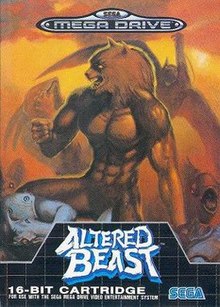
The Sega CD, known as Mega-CD in most regions outside North America and Brazil, is a CD-ROM accessory for the Sega Genesis produced by Sega as part of the fourth generation of video game consoles. It was released on December 12, 1991, in Japan, October 15, 1992, in North America, and April 2, 1993, in Europe. The Sega CD plays CD games and adds hardware functionality such as a faster CPU and graphic enhancements such as sprite scaling and rotation. It can also play audio CDs and CD+G discs.

The Master System is an 8-bit third-generation home video game console manufactured and developed by Sega. It was originally a remodeled export version of the Sega Mark III, the third iteration of the SG-1000 series of consoles, which was released in Japan in 1985 with graphical capabilities improved over its predecessors. The Master System launched in North America in 1986, followed by Europe in 1987, and then in Brazil and Korea in 1989. A Japanese version of the Master System was also launched in 1987, which features a few enhancements over the export models : a built-in FM audio chip, a rapid-fire switch, and a dedicated port for the 3D glasses. The Master System II, a cheaper model, was released in 1990 in North America, Australasia and Europe.

Earthworm Jim is a 1994 run and gun platform game developed by Shiny Entertainment, featuring an earthworm named Jim, who wears a robotic suit and battles the forces of evil. The game was released for the Sega Genesis and Super Nintendo Entertainment System, before being subsequently ported to a number of other video game consoles.
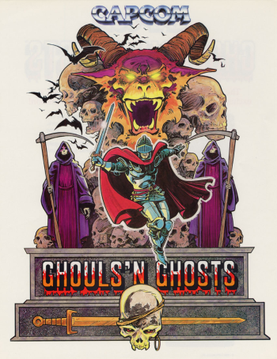
Ghouls 'n Ghosts, known as Dai Makaimura in Japan, is a side-scrolling platform game developed by Capcom, released as an arcade video game in 1988 and ported to home platforms. It is the sequel to Ghosts 'n Goblins and the second game in the Ghosts 'n Goblins series.

Columns is a match-three puzzle video game released by Jay Geertsen in 1989. Designed for the 68000-based HP 9000 running HP-UX, it was ported to Mac and DOS before being released commercially by Sega who ported it to arcades and then to several Sega consoles. The game was subsequently ported to other home computer platforms, including the Atari ST.

Sonic the Hedgehog is a 1991 platform game developed by Sonic Team and published by Sega for the Genesis/Mega Drive. It was released in North America on June 23 and in PAL regions and Japan the following month. Players control Sonic the Hedgehog, who can run at near supersonic speeds; Sonic sets out on a quest to defeat Dr. Robotnik, a scientist who has imprisoned animals in robots and seeks the powerful Chaos Emeralds. The gameplay involves collecting rings as a form of health, and a simple control scheme, with jumping and attacking controlled by a single button.
In the history of video games, the fourth generation of video game consoles, more commonly referred to as the 16-bit era, began on October 30, 1987, with the Japanese release of NEC Home Electronics' PC Engine. Though NEC released the first console of this era, sales were mostly dominated by the rivalry between Sega and Nintendo across most markets: the Sega Mega Drive and the Super Nintendo. Cartridge-based handheld game consoles became prominent during this time, such as the Nintendo Game Boy, Atari Lynx, Sega Game Gear and TurboExpress.

Super Street Fighter II: The New Challengers is a competitive fighting game produced by Capcom and originally released as an arcade game in 1993. It is the fourth game in the Street Fighter II sub-series of Street Fighter games, following Street Fighter II: Hyper Fighting. It refines and balances the existing character roster from the previous versions, and introduces four new characters. It is the first game on Capcom's CP System II hardware, with more sophisticated graphics and audio over the original CP System hardware used in previous versions of Street Fighter II.
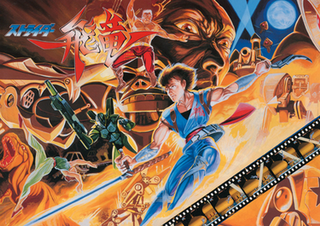
Strider, released in Japan as Strider Hiryū, is a hack-and-slash platform game released in arcades in 1989 by Capcom. Set in a dystopian future where Earth is ruled by the tyrannical Grandmaster Meio, it follows the titular Strider named Hiryu as he attempts to end his tyrannical reign for good. The game resulted from cooperation between Capcom and manga publisher Moto Kikaku. It marked the video game debut of Strider Hiryu, after the character was introduced in the 1988 manga Strider Hiryu.
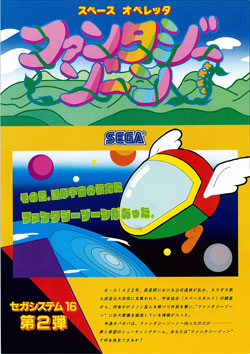
Fantasy Zone is a 1986 arcade video game by Sega, and the first game in the Fantasy Zone series. It was later ported to a wide variety of consoles, including the Master System. The player controls a sentient spaceship named Opa-Opa who fights an enemy invasion in the titular group of planets. The game contains a number of features atypical of the traditional scrolling shooter. The main character, Opa-Opa, is sometimes referred to as Sega's first mascot character.

Virtua Racing or V.R. for short, is a Formula One racing video game developed by Sega AM2 and released for arcades in 1992. Virtua Racing was initially a proof-of-concept application for exercising a new 3D graphics platform under development, the "Model 1". The results were so encouraging that Virtua Racing was fully developed into a standalone arcade title.

Golden Axe is a side-scrolling hack-and-slash video game released by Sega for arcades in 1989, running on the Sega System 16B arcade hardware. Makoto Uchida was the lead designer of the game, and was also responsible for the creation of the previous year's Altered Beast. The game casts players as one of three warriors who must free the fantastical land of Yuria from the tyrannical rule of Death Adder, who wields the titular Golden Axe.

Streets of Rage 2, known as Bare Knuckle II in Japan, is a 1992 side-scrolling beat 'em up video game published by Sega for the Genesis/Mega Drive. A sequel to Streets of Rage (1991), the characters Axel Stone and Blaze Fielding return while the game also introduces two new characters: Max Thunder, and Eddie "Skate" Hunter, the younger brother of Adam Hunter from the first game.

Bonanza Bros. is a 3D-style, 2D side-scrolling stealth action game developed and released by Sega in 1990. It is one of the earliest arcade games powered by the Sega System 24 arcade system board. It was ported to various home systems, including the Mega Drive/Genesis, Master System, PC-Engine/TurboGrafx-CD, and several home computers.

The Sega Genesis, also known as the Mega Drive outside North America, is a 16-bit fourth generation home video game console developed and sold by Sega. It was Sega's third console and the successor to the Master System. Sega released it in 1988 in Japan as the Mega Drive, and in 1989 in North America as the Genesis. In 1990, it was distributed as the Mega Drive by Virgin Mastertronic in Europe, Ozisoft in Australasia, and Tectoy in Brazil. In South Korea, it was distributed by Samsung Electronics as the Super Gam*Boy and later the Super Aladdin Boy.
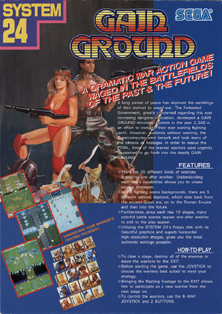
Gain Ground is an action game with strategy elements released as an arcade video game by Sega in 1988. It was ported to the Master System, Mega Drive/Genesis, and TurboGrafx-CD.
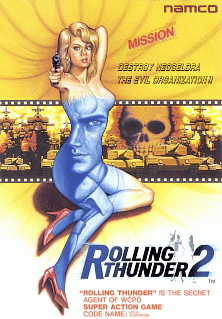
Rolling Thunder 2 is a run and gun arcade game developed and released by Namco for the Namco System 2 hardware in 1991. The game is the sequel to 1986's Rolling Thunder, retaining the same gameplay of its predecessor but adding cooperative gameplay for two players and improved graphics. Unlike the original, which was based in 1968, Rolling Thunder 2 has a more contemporary setting to go with its more futuristic design, as well as an optionally playable female character. A port for the Sega Genesis was released the same year. Both the Mega Drive port and the original arcade game were released for the Wii Virtual Console on December 4, 2007 and October 27, 2009 respectively.
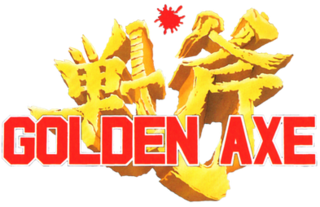
Golden Axe is a series of side-scrolling beat 'em up arcade video games developed by Sega. The series takes place in a medieval fantasy world where several heroes have the task of recovering the legendary Golden Axe, the mainstay element of the series.
In the video game industry, a console war describes the competition between two or more video game console manufacturers in trying to achieve better consumer sales through more advanced console technology, an improved selection of video games, and general marketing around their consoles. While console manufacturers are generally always trying to out-perform other manufacturers in sales, these console wars engage in more direct tactics to compare their offerings directly against their competitors or to disparage the competition in contrast to their own, and thus the marketing efforts have tended to escalate in back-and-forth pushes.
